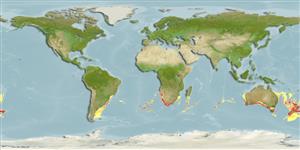Common names from other countries
Environment: milieu / climate zone / depth range / distribution range
Sinh thái học
Biển Sống nổi và đáy; Mức độ sâu 40 - 1500 m (Ref. 52180), usually 260 - 490 m (Ref. 52180). Deep-water; 19°S - 55°S, 67°W - 173°W
Southwest Atlantic: Argentina. Southeast Atlantic and Western Indian Ocean: South Africa. Southwest Pacific: New Zealand and Australia (including Western Australia).
Length at first maturity / Bộ gần gũi / Khối lượng (Trọng lượng) / Age
Maturity: Lm 70.6, range 59 - ? cm
Max length : 140 cm TL con đực/không giới tính; (Ref. 9563); common length : 60.0 cm TL con đực/không giới tính; (Ref. 52180); Khối lượng cực đại được công bố: 63.0 kg (Ref. 54802); Tuổi cực đại được báo cáo: 15 các năm (Ref. 9072)
Các tia vây lưng cứng (tổng cộng) : 7 - 8; Các vây lưng mềm (tổng cộng) : 19 - 21; Tia cứng vây hậu môn: 3; Tia mềm vây hậu môn: 15 - 17. Uniformly dark to black.
Most common over or near rocky areas at 100-300 m (Ref. 9258). Generally, blue eye remain close to the sea bed during the day and move up in the water column at night, following concentrations of food (Ref. 6390). The fish are found over rough ground and at the edges of canyons and steep drop-offs. Blue eye appear to prefer cold water as part of their general behavior (Ref. 6390). Juveniles inhabit surface waters, sometimes in association with floating debris (Ref. 6390). Feed primarily on the pelagic tunicate Pyrosoma atlantica which is found near the sea bed during the day but dispersed throughout the water column at night (Ref. 7129, 30454). They also feed on squid, mollusks and crustaceans (Ref. 30455, 30454) and fish ranging from small lanternfish (Myctophidae) to large fish such as gemfish (Rexea solandri). Juveniles consume small planktonic and sedentary organisms (Ref. 30456). Marketed fresh and frozen; exported to Japan for sashimi; eaten steamed, fried, broiled and baked (Ref. 9988).
In Australia, spawning appears to be correlated with water temperature and nutrient upwellings (Ref. 7129). It appears that mature fish move up the continental slope into shallow depths (320-400 m) and aggregate in specific grounds for spawning (Ref. 6390).
There is no information on the number of eggs blue eye produce nor on the egg and larval stages of their life history (Ref. 6390).
Haedrich, R.L., 1986. Stromateidae. p. 842-846. In M.M. Smith and P.C. Heemstra (eds.) Smiths' sea fishes. Springer-Verlag, Berlin. (Ref. 4410)
IUCN Red List Status (Ref. 130435)
CITES (Ref. 128078)
Not Evaluated
Threat to humans
Harmless
Human uses
Can't connect to MySQL database (fbapp). Errorcode: Too many connections
